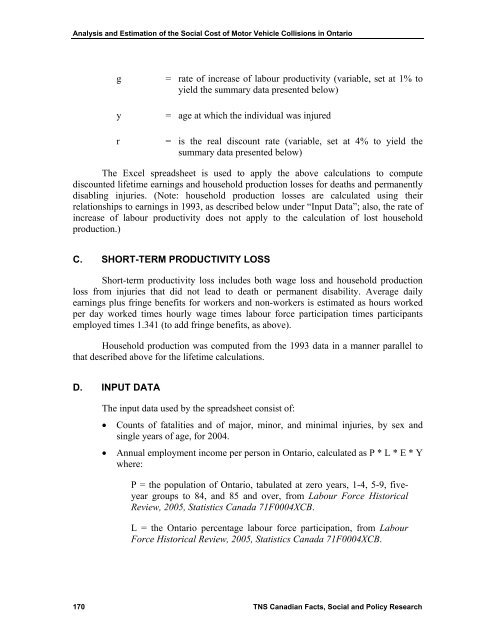Keith Vodden Dr. Douglas Smith - Transports Canada
Keith Vodden Dr. Douglas Smith - Transports Canada
Keith Vodden Dr. Douglas Smith - Transports Canada
Create successful ePaper yourself
Turn your PDF publications into a flip-book with our unique Google optimized e-Paper software.
Analysis and Estimation of the Social Cost of Motor Vehicle Collisions in Ontario<br />
g<br />
y<br />
r<br />
= rate of increase of labour productivity (variable, set at 1% to<br />
yield the summary data presented below)<br />
= age at which the individual was injured<br />
= is the real discount rate (variable, set at 4% to yield the<br />
summary data presented below)<br />
The Excel spreadsheet is used to apply the above calculations to compute<br />
discounted lifetime earnings and household production losses for deaths and permanently<br />
disabling injuries. (Note: household production losses are calculated using their<br />
relationships to earnings in 1993, as described below under “Input Data”; also, the rate of<br />
increase of labour productivity does not apply to the calculation of lost household<br />
production.)<br />
C. SHORT-TERM PRODUCTIVITY LOSS<br />
Short-term productivity loss includes both wage loss and household production<br />
loss from injuries that did not lead to death or permanent disability. Average daily<br />
earnings plus fringe benefits for workers and non-workers is estimated as hours worked<br />
per day worked times hourly wage times labour force participation times participants<br />
employed times 1.341 (to add fringe benefits, as above).<br />
Household production was computed from the 1993 data in a manner parallel to<br />
that described above for the lifetime calculations.<br />
D. INPUT DATA<br />
The input data used by the spreadsheet consist of:<br />
• Counts of fatalities and of major, minor, and minimal injuries, by sex and<br />
single years of age, for 2004.<br />
• Annual employment income per person in Ontario, calculated as P * L * E * Y<br />
where:<br />
P = the population of Ontario, tabulated at zero years, 1-4, 5-9, fiveyear<br />
groups to 84, and 85 and over, from Labour Force Historical<br />
Review, 2005, Statistics <strong>Canada</strong> 71F0004XCB.<br />
L = the Ontario percentage labour force participation, from Labour<br />
Force Historical Review, 2005, Statistics <strong>Canada</strong> 71F0004XCB.<br />
170 TNS Canadian Facts, Social and Policy Research
















